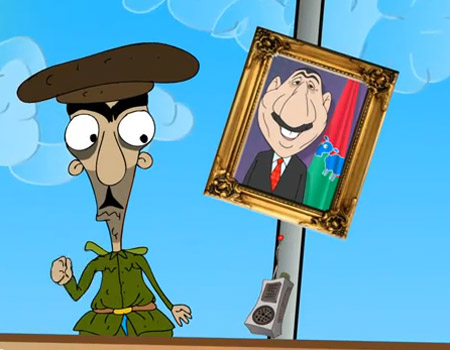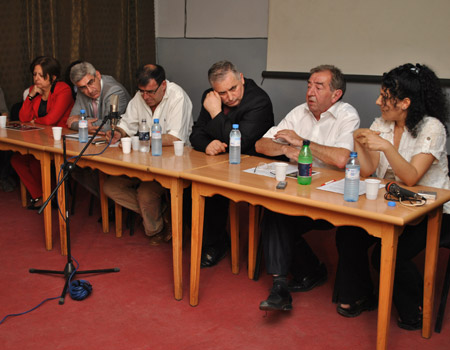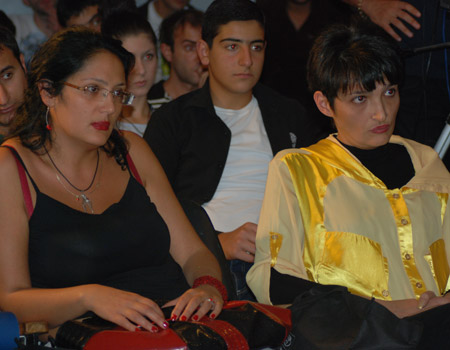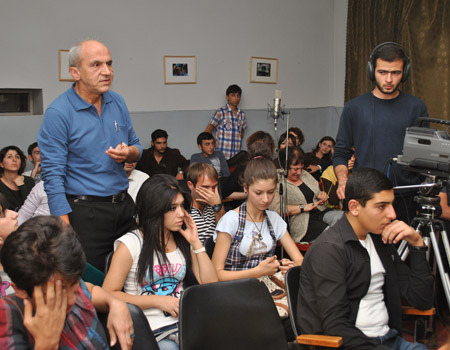The civil hearing. or people’s court, titled “Preaching violence and racism under the auspices of the informational war — Who does it harm?” organized by the South Caucasus Court of Human Rights in Armenia began on Friday with a screening of two short clips comprised of found and edited footage and one cartoon.
One of the films was a clip showing scenes from the Nagaorno-Karabakh War, accompanied by music. Azerbaijani POWs (prisoners of war) were marching to the tune of an Azerbaijani military march. Seen in the upper left-hand corner of the screen throughout the entire duration of the film was an Azerbaijani flag — in the appearance of a roll of toilet paper. Periodically appearing was the image of Azerbaijani President Ilham Aliyev, who, due to the art of editing, appeared to be kissing the Armenian flag.
But mostly the scenes alternated between Azerbaijani militia, including their mutilated corpses, and the power of the Armenian army. The two films were quite similar and, in fact, repeatedly included the same footage. The display of Azeri POWs was accompanied by the sound of bleating sheep. In one scene, an Azeri POW is forced to lick the chevron on the enemy’s coat (which designates an officer’s ranking). Documentary footage of hazing in the Azerbaijani army can be seen several times in the video with dance club music playing the background. The soldiers are beaten, they are forced to slap each other and so on. Armenian troops shoot, bomb, fly planes and take enemy prisoners.
The animation film was about an incident that takes place on the border, where a blond, blue-eyed, broad-shouldered Armenian soldier is guarding the border, while on the other side is the small, mustached enemy soldier with a large head. The latter is seen raping a sheep at the guard tower where hangs a portrait of the president and below it, a pile of fecal matter. In this episode, in order to take down the Armenian guard, the Azerbaijani soldier resorts to assistance from an English-speaking female sniper who requires two cans of oil, one of which the Azerbaijani soldier pisses in.
The sniper takes aim at the Armenian soldier and misses because she gets accosted by the horny Azeri soldier who was turned on by the sight of her behind. The sniper, beating up the soldier and pouring one of the cans of oil over him (the one with his piss), takes off by helicopter.
Taking advantage of the soldier’s helplessness, the sheep from the previous scene decides to take revenge by raping the soldier in the same way he raped him. At the end of the cartoon, Azerbaijan’s president described the incident on television. The characters voices are heard with an imitation of an accent and Azeri words and phrases are used.
The experts invited to the court were to comment on what they saw, respond to questions, listen to comments from the floor and vote in favor or against the justification of racist propaganda disguised as information warfare.
The expected scandal didn’t happen: director Armen Mazmanyan, who “doesn’t believe genetically in Turks,” was not present and Union of Exiled Armenian Writers and Intellectuals member, one of the founders of the ruling Republican Party of Armenia Vahe Avetian had sent his opinion by video from Sweden.
The latter, in particular, said: “In the first two videos, which demonstrate the humiliation of Azerbaijani POWs, I was forced to return [to the films] several times because I could not watch them till the end. I was disgusted and I feel the same way now. My former brainwashed self always believed that the virtue of our heroes comes from [national epic hero] David of Sasun and that the Armenian hero cannot humiliate an unarmed and defenseless man.
“Now I have a better idea of what’s what. These two pieces are not part of the information war. And if this is war, then it is directed against the creators of this film, and not against those who humiliate and break the spirit of an hapless man. It is they who later became cops and security officers. This type of human kills the Armenian soldier in the army, subjects him to torture just the same as those in the video who show the inside of the Azerbaijani army.
“It’s worth noting that Russian arms are obviously advertised in the plot, from which conclusions can be drawn about those who commissioned the film.
“Who is harmed by the propaganda of violence and racism under the guise of an information war? In the first place, the racists themselves because sooner or later they will be called to account as happens with all racists and fascists in history. Being ignorant, as racists and fascists usually are, our compatriots don’t know this. They are characterized by a stupid delusion of impunity.
“In the cartoon, everything is different: they are professionally made and witty, and aimed at children. And this fact that in a 5-month period, they have been viewed 90,000 times proves that they are reaching their destination — which is dangerous. Children can easily fall into this trap. This is a large-scale war against us, which is aimed at turing young people into puppets and cannon fodder for the aggressive policies of the next decade.
“I think that it is necessary to prevent this, consistently highlighting the problem and eliminating such sites. For this purpose there are corresponding opportunities. We only need to be organized in our work.”
Then head of the YSU (Yerevan State University) Department of General Psychology Hrant Avanesyan took the floor:
“Racism and violence are evident in the video. They have a particular destination and they reach it. I conducted a small survey and found out that positive feedback about these subjects come from adolescents aged 16–19. Such subjects cannot affect our generation. They are not aimed at the intellectual stratum.”
Dean of the Faculty of Cinema at the Yerevan State Institute of Theatre and Cinematography Ms. Sargsyan, in turn, said that “self-criticism is a good thing, but in this case we’re talking about a type of human who ridicules and humiliates his neighbor. I am ashamed not for Armenian but for those who are not few in every nation. I say ‘no’ to racism and violence, and this has nothing to do with Armenians — this is a flaw of humanity, against which everyone must fight.”
Herold Yeremia Alexanian from France noted that as a European he condemns any manifestations of xenophobia and violence, but when these are attributed to Armenians, it’s necessary to consider that this is the reaction to long-term manifestations of fascism by the Turks against the Armenians. The psychologist emphasized that by “Turks” he also means Azerbaijanis. Alexanian was speaking through a translator, occasionally correcting him.
Alexanian’s opinion was met with fiery support by attending bloggers and “fighters of anti-Armenian propaganda,” as they introduced themselves. In their remarks, they insisted that the videos screened were extremely unprofessional and had the opposite effect (than they intended).
Many of those who spoke, including students, demanded that Azerbaijani propaganda materials also be discussed and demonstrated at such events.
Moderator, “South Caucasus Court in Armenia” program director, Caucasus Center of Peace-Making Initiatives President Georgy Vanyan often had to ask attendees to keep to the topic. He expressed willingness to participate in all events that will be organized by the “anti-propagandists” present at this event. Vanyan also emphasized that the two videos discussed (the cartoon was not discussed as much) were downloaded from the website of Armenian students in St. Petersburg, who are also the authors of the work. There were opinions on the floor that the videos were produced in Baku in order to discredit the Armenian side.
When it came time to vote and attendees were told they could not abstain, a large part of those present left the room. The French psychologist and one of the videographers filming the event voted in favor of “preaching violence and racism under the guise of an information war,” while more than 20 people were against.
Photos: South Caucasus Integration: Alternative Start website
 Epress.am News from Armenia
Epress.am News from Armenia








